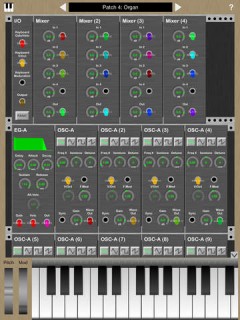 Developer Ryouta Kira has introduced KQ MiniSynth – a polyphonic modular synthesizer for iOS.
Developer Ryouta Kira has introduced KQ MiniSynth – a polyphonic modular synthesizer for iOS.
The software modular lets you create patches with up to 100 modules and supports hardware MIDI control and Inter-App Audio.
It requires iOS 6.0 or later, and is compatible with iPhone, iPad, and iPod touch.
This app implements the following modules:
Oscillator
– Oscillator Type A (Frequency Modulation)
– Oscillator Type B (Pulse Width Modulation)
– Super Saw Oscillator
– Low Frequency Oscillator
– White Noise Generator
Mixer/Amplifier
– 4 Channel Mixer
– Voltage-Controlled Amplifier
– Sample-and-Hold Amplifier
– Booster
Envelope/Logic
– Envelope Generator Type A
– Envelope Generator Type B
– Inverting Circuit
– Logical And (Series Switch)
– Logical Or (Parallel Switch)
– Maximum/Minimum Selector
Modulator
– V/Oct Vibrator
– Keyboard Level Scaling
– Ring Modulator
Filter/Effector
– Voltage-Controlled Filter (LPF/HPF/BPF/BEF)
– Delay Effector
– Reverb Filter
– Compressor
Note: Recommended Minimum Device: iPhone 5, iPad 2, or newer.
KQ MiniSynth is available for US $3.99 in the App Store.

demo?
What size sockets does it use?
Sorry to sound like I’m nit picking…but the graphics could look a bit nicer.
I know this does nothing for the over function of the app itself but it might improve app sales for people that buy app primarily from the way they look.
I feel bad for judging it in this manner, but I too cannot get past how awful the thing looks. I have a similar problem with Wolfgang Palm’s recent works. The synths are fantastic but I never use them because the GUI’s are atrocious.
Ah, vanity.
I just don’t understand the allure of a virtual modular system. Seems like taking ten steps backwards, just to be ‘on trend’.
Of course, this is assuming that people who are into modular are so partially due to the hands-on nature of modular synths.
For me, it’s a great way to get started in modular. I simply cannot afford to build even a simple modular unit, and using something like Pulse Code’s Modular Synth app has allowed me to get a feel for this type of synthesis without having to make that investment. That being said, I’ve learned enough now to know that one day I would like to build a real system – something I probably never would have considered had it not been for trying things out in iOS.
I like the idea of a soft modular, as long as it has a good MIDI spec. for ‘real’ control. Modular is about sonic flexibility. Patching a sound is the same in hardware and software. Once it’s right it doesn’t matter how you get it!
Zmors modular is a great modular app. Id be curious as to what this one sounds like, no demo in the app store.
https://www.youtube.com/watch?v=wNuBUTZ_GRc
Just picked this up. Universal though tiny on my iPhone 6+. It sounds pretty good. I like it. Note it supports both AU and IAA. It has a full IAA Transport for starting, stopping, recording and return to IAA Host.
I got this KQ MiniSynth a few days ago, and for the life of me I cannot figure out how to properly save my patches. I click on the title like it says to bring up the save dialog window, and it has a “save” button, which if pushed allows the input if a name, but there seems to be no way to finally actually “save” it, there are only the options to load another patch or cancel, and if I change patches after that, all my work is lost. I have searched for a few hours for solutions but cannot find any. Help please, otherwise without being able to really save, this app is basically useless to me.
Ok I finally figured it out but it was not at all obvious or intuitive. Now I love this app haha
Now KQ MiniSynth has 70 presets and 31 kinds of modules.